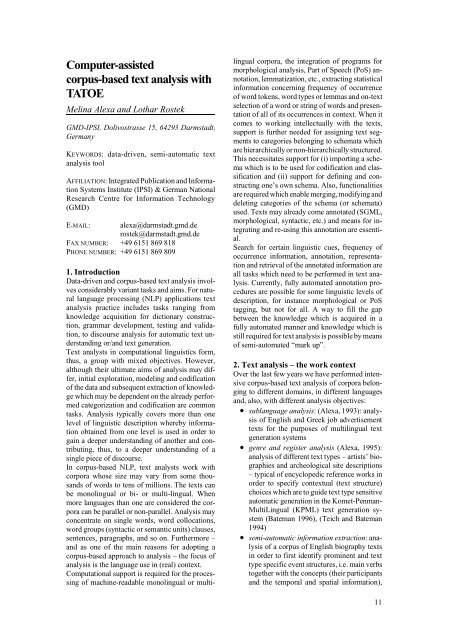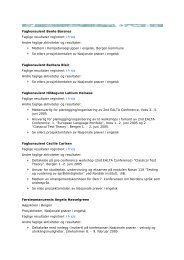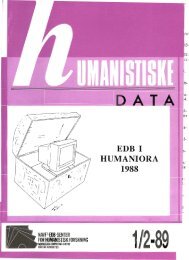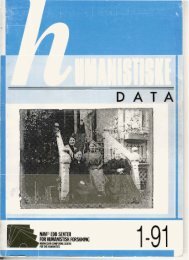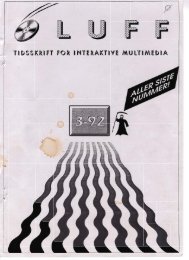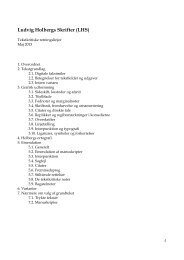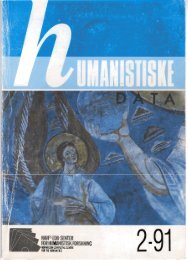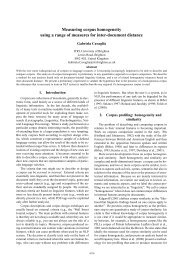Computer-assisted corpus-based text analysis with TATOE
Computer-assisted corpus-based text analysis with TATOE
Computer-assisted corpus-based text analysis with TATOE
You also want an ePaper? Increase the reach of your titles
YUMPU automatically turns print PDFs into web optimized ePapers that Google loves.
<strong>Computer</strong>-<strong>assisted</strong><br />
<strong>corpus</strong>-<strong>based</strong> <strong>text</strong> <strong>analysis</strong> <strong>with</strong><br />
<strong>TATOE</strong><br />
Melina Alexa and Lothar Rostek<br />
GMD-IPSI, Dolivostrasse 15, 64293 Darmstadt,<br />
Germany<br />
KEYWORDS: data-driven, semi-automatic <strong>text</strong><br />
<strong>analysis</strong> tool<br />
AFFILIATION: Integrated Publication and Information<br />
Systems Institute (IPSI) & German National<br />
Research Centre for Information Technology<br />
(GMD)<br />
E-MAIL: alexa@darmstadt.gmd.de<br />
rostek@darmstadt.gmd.de<br />
FAX NUMBER: +49 6151 869 818<br />
PHONE NUMBER: +49 6151 869 809<br />
1. Introduction<br />
Data-driven and <strong>corpus</strong>-<strong>based</strong> <strong>text</strong> <strong>analysis</strong> involves<br />
considerably variant tasks and aims. For natural<br />
language processing (NLP) applications <strong>text</strong><br />
<strong>analysis</strong> practice includes tasks ranging from<br />
knowledge acquisition for dictionary construction,<br />
grammar development, testing and validation,<br />
to discourse <strong>analysis</strong> for automatic <strong>text</strong> understanding<br />
or/and <strong>text</strong> generation.<br />
Text analysts in computational linguistics form,<br />
thus, a group <strong>with</strong> mixed objectives. However,<br />
although their ultimate aims of <strong>analysis</strong> may differ,<br />
initial exploration, modeling and codification<br />
of the data and subsequent extraction of knowledge<br />
which may be dependent on the already performed<br />
categorization and codification are common<br />
tasks. Analysis typically covers more than one<br />
level of linguistic description whereby information<br />
obtained from one level is used in order to<br />
gain a deeper understanding of another and contributing,<br />
thus, to a deeper understanding of a<br />
single piece of discourse.<br />
In <strong>corpus</strong>-<strong>based</strong> NLP, <strong>text</strong> analysts work <strong>with</strong><br />
corpora whose size may vary from some thousands<br />
of words to tens of millions. The <strong>text</strong>s can<br />
be monolingual or bi- or multi-lingual. When<br />
more languages than one are considered the corpora<br />
can be parallel or non-parallel. Analysis may<br />
concentrate on single words, word collocations,<br />
word groups (syntactic or semantic units) clauses,<br />
sentences, paragraphs, and so on. Furthermore –<br />
and as one of the main reasons for adopting a<br />
<strong>corpus</strong>-<strong>based</strong> approach to <strong>analysis</strong> – the focus of<br />
<strong>analysis</strong> is the language use in (real) con<strong>text</strong>.<br />
Computational support is required for the processing<br />
of machine-readable monolingual or multi-<br />
lingual corpora, the integration of programs for<br />
morphological <strong>analysis</strong>, Part of Speech (PoS) annotation,<br />
lemmatization, etc., extracting statistical<br />
information concerning frequency of occurrence<br />
of word tokens, word types or lemmas and on-<strong>text</strong><br />
selection of a word or string of words and presentation<br />
of all of its occurrences in con<strong>text</strong>. When it<br />
comes to working intellectually <strong>with</strong> the <strong>text</strong>s,<br />
support is further needed for assigning <strong>text</strong> segments<br />
to categories belonging to schemata which<br />
are hierarchically or non-hierarchically structured.<br />
This necessitates support for (i) importing a schema<br />
which is to be used for codification and classification<br />
and (ii) support for defining and constructing<br />
one’s own schema. Also, functionalities<br />
are required which enable merging, modifying and<br />
deleting categories of the schema (or schemata)<br />
used. Texts may already come annotated (SGML,<br />
morphological, syntactic, etc.) and means for integrating<br />
and re-using this annotation are essential.<br />
Search for certain linguistic cues, frequency of<br />
occurrence information, annotation, representation<br />
and retrieval of the annotated information are<br />
all tasks which need to be performed in <strong>text</strong> <strong>analysis</strong>.<br />
Currently, fully automated annotation procedures<br />
are possible for some linguistic levels of<br />
description, for instance morphological or PoS<br />
tagging, but not for all. A way to fill the gap<br />
between the knowledge which is acquired in a<br />
fully automated manner and knowledge which is<br />
still required for <strong>text</strong> <strong>analysis</strong> is possible by means<br />
of semi-automated “mark up”.<br />
2. Text <strong>analysis</strong> – the work con<strong>text</strong><br />
Over the last few years we have performed intensive<br />
<strong>corpus</strong>-<strong>based</strong> <strong>text</strong> <strong>analysis</strong> of corpora belonging<br />
to different domains, in different languages<br />
and, also, <strong>with</strong> different <strong>analysis</strong> objectives:<br />
• sublanguage <strong>analysis</strong>: (Alexa, 1993): <strong>analysis</strong><br />
of English and Greek job advertisement<br />
<strong>text</strong>s for the purposes of multilingual <strong>text</strong><br />
generation systems<br />
• genre and register <strong>analysis</strong> (Alexa, 1995):<br />
<strong>analysis</strong> of different <strong>text</strong> types – artists’ biographies<br />
and archeological site descriptions<br />
– typical of encyclopedic reference works in<br />
order to specify con<strong>text</strong>ual (<strong>text</strong> structure)<br />
choices which are to guide <strong>text</strong> type sensitive<br />
automatic generation in the Komet-Penman-<br />
MultiLingual (KPML) <strong>text</strong> generation system<br />
(Bateman 1996), (Teich and Bateman<br />
1994)<br />
• semi-automatic information extraction: <strong>analysis</strong><br />
of a <strong>corpus</strong> of English biography <strong>text</strong>s<br />
in order to first identify prominent and <strong>text</strong><br />
type specific event structures, i.e. main verbs<br />
together <strong>with</strong> the concepts (their participants<br />
and the temporal and spatial information),<br />
11
parse these events and update the knowledge<br />
base used for the Editor’s Workbench application<br />
(for the general con<strong>text</strong> of this work<br />
see Rostek et al., 1994 and Rostek and Moehr,<br />
1994)<br />
• domain specific thesaurus construction: <strong>analysis</strong><br />
of press release messages issued by the<br />
Deutsche Presse Agentur (DPA) for the construction<br />
of a semantic network to support<br />
fact extraction from these messages<br />
• thematic development in encyclopedic reference<br />
<strong>text</strong>s: exploration, determination and<br />
subsequent specification of thematic development<br />
preferences typical of English artist<br />
biographies and archeological site descriptive<br />
<strong>text</strong>s in order to specify the <strong>text</strong> type<br />
specific thematic choices for automatic <strong>text</strong><br />
generation.<br />
For all the above objectives computational support<br />
has been required to structure, compile and edit the<br />
<strong>text</strong> data and to further annotate parts of the <strong>text</strong><br />
corpora and extract linguistically variant<br />
knowledge.<br />
Aiming at supporting such <strong>text</strong> <strong>analysis</strong> tasks as<br />
the ones listed above we have designed and implemented<br />
<strong>TATOE</strong>, a Text Analysis Tool <strong>with</strong> Object<br />
Encoding, the functionalities of which we present<br />
in this paper. Section 3 lists specific requirements<br />
for supporting computationally <strong>corpus</strong>-<strong>based</strong> <strong>text</strong><br />
<strong>analysis</strong> and presents some of the current tools for<br />
this task. Section 4 describes <strong>TATOE</strong> and its main<br />
functionalities. Section 5 provides the technical<br />
characteristics of the tool. Finally, section 6 presents<br />
the future directions of this work and concludes<br />
the paper.<br />
3. Requirements for supporting <strong>text</strong><br />
<strong>analysis</strong> computationally<br />
The general situation in <strong>corpus</strong>-<strong>based</strong> <strong>text</strong> <strong>analysis</strong><br />
can be described as one where particular linguistic<br />
phenomena observed in the <strong>corpus</strong> need to be<br />
interpreted <strong>with</strong>in a theoretical framework. This<br />
interpretation may be an intellectual task typical<br />
of scientific work for <strong>analysis</strong>, understanding and<br />
explanation of <strong>text</strong>s. A tool for semi-automated<br />
support <strong>analysis</strong>, then, needs to provide an integrated<br />
and user-friendly working environment whereby<br />
at least the following are supported:<br />
• compiling and importing one or more <strong>text</strong><br />
corpora<br />
• importing an already existing a – hierarchically<br />
or non-hierarchically – structured<br />
knowledge classification schema<br />
• definition and construction of one’s own<br />
classification schema<br />
• development or usage of one or more classification<br />
schemata for annotation and, thus,<br />
12<br />
knowledge categorization enabling annotation<br />
of <strong>text</strong> segments (words, groups of<br />
words, etc.) according to the schema used<br />
• interactive annotation by mechanisms that<br />
are flexible and easy to use on <strong>text</strong> selections<br />
• enabling work <strong>with</strong> more than one categorization<br />
schemata concurrently, so that the<br />
analyst can work separately <strong>with</strong> different<br />
levels of linguistic description, e.g. morphological,<br />
lexical, syntactic, etc., and at the<br />
same time integrate information from different<br />
schemata (for most <strong>text</strong> <strong>analysis</strong> tasks<br />
integration of different kinds of linguistic<br />
knowledge is a requisite)<br />
• the integration of already existing automatic<br />
tagging/encoding tools for an initial annotation<br />
and enabling work <strong>with</strong> already annotated<br />
corpora, e.g. <strong>with</strong> SGML, PoS<br />
annotation, etc.<br />
• flexibly viewing already encoded <strong>text</strong> segments;<br />
this includes both selecting and arranging<br />
according to different criteria<br />
(frequency of occurrences, encoded category<br />
types, etc.) and presenting information <strong>with</strong><br />
readable layout styles (fonts, colours)<br />
• concordance list presentations<br />
• calculating different statistics for every word<br />
and every annotated <strong>text</strong> segment and this on<br />
the basis of the (hierarchical or non-hierarchical)<br />
relations <strong>with</strong>in the categorization<br />
schema, e.g. frequency of occurrence of<br />
word tokens, word types, schema categories,<br />
or demonstration of how these elements are<br />
distributed in one or all <strong>text</strong>s<br />
• providing solutions or mechanisms for exporting<br />
both annotated and non-annotated<br />
information in different formats, e.g. SGML,<br />
for further processing<br />
• multilingual <strong>text</strong> <strong>analysis</strong>.<br />
Current available tools and programs which may<br />
support the above <strong>text</strong> <strong>analysis</strong> requirements can<br />
be categorized according to <strong>corpus</strong> processing<br />
tools, general <strong>text</strong> <strong>analysis</strong> tools <strong>with</strong> retrieval<br />
capabilities, and annotation tools or programs, i.e.<br />
taggers. To give just a flavour of these consider:<br />
the DTTool for tagging corpora for anaphora<br />
(Aone and Bennett, 1994), the INTEX <strong>corpus</strong><br />
processing system (Silberztein 1994), the COS-<br />
MAS <strong>corpus</strong> storage, maintenance and access system<br />
<strong>with</strong> built-in corpora (al-Wadi, 1994), the<br />
WordCruncher, a flexible PC-<strong>based</strong> <strong>text</strong> retrieval<br />
<strong>corpus</strong> exploration tool (available from IKS,<br />
Bonn), TACT (Bradley,1990) and Lexa (Hickey,<br />
1992) for general <strong>text</strong> exploration <strong>with</strong> presenting<br />
information in the form of concordance lists and<br />
statistical tables, the knowledge extraction tools<br />
KES and GRAAL (as described in (Ogonowski et
al. 1994)), the Xtract tool (Smadja and McKeown,<br />
1990) for automatically extracting word collocational<br />
information and the WAG-coder (O’ Donnell,<br />
1995) for systemic functional linguistics<br />
oriented <strong>analysis</strong>.<br />
The main weakness of the current systems is that<br />
no support is offered in an integrated manner<br />
where different <strong>analysis</strong> perspectives can be employed<br />
in one working environment and different<br />
kinds of information extracted or made available<br />
concurrently. Weaknesses usually include one or<br />
more of the following: inflexible data model (e.g.<br />
the data basis is the whole <strong>corpus</strong> and the <strong>corpus</strong><br />
parts such as <strong>text</strong>s, paragraphs, etc. are not separated),<br />
theory-dependence, domain-dependence,<br />
applicable only for one level of linguistic <strong>analysis</strong>,<br />
non-linguistically motivated, inability to either<br />
import an already existing classification schema<br />
or to provide support for consistently and efficiently<br />
building one, non-portability, inflexible<br />
user interface, lack of multilingual support.<br />
Figure 1: A screen dump of <strong>TATOE</strong><br />
4. Text Analysis Tool <strong>with</strong> Object<br />
Encoding<br />
Based on the variant nature of the work and objectives<br />
described in section 2 we have designed<br />
<strong>TATOE</strong>, a tool for a data-driven and multi-layered<br />
<strong>text</strong> <strong>analysis</strong>. Our intention has been that the tool<br />
is language and semantic domain independent,<br />
that one or more categorization schema(ta) for<br />
encoding can be flexibly developed by the user or<br />
imported in the tool, and that the tool is portable<br />
between different hardware platforms.<br />
The implementation of <strong>TATOE</strong> took the requirements<br />
listed earlier as its starting point. We designed<br />
an object-oriented data model – using the<br />
Smalltalk Frame Kit (SFK), an object oriented<br />
modeling tool offering a spectrum of features to<br />
make model descriptions operational (Fischer and<br />
Rostek 1996) – for the representation of the different<br />
kinds of information to be stored in a kind of<br />
‘personalized annotation database’. In such a database<br />
the <strong>text</strong> segments are linked to elements of<br />
categorization schemata so that the database contents<br />
can be seen as a network of information units.<br />
We use an object-oriented approach to handle a<br />
fine granular network of highly interlinked information<br />
units (objects).<br />
A general picture of the tool is given in figure 1.<br />
13
The variety of information presented on the screen<br />
is arranged in five separate panes in order to keep<br />
<strong>corpus</strong> <strong>text</strong>s and information about these <strong>text</strong>(s)<br />
side by side. These panes are: the main <strong>text</strong> pane<br />
in the middle, the list of <strong>text</strong>s at the top left, the<br />
word list pane underneath it. On the top right there<br />
is the list of categories above the list of marked<br />
instances. With the exception of the <strong>text</strong> list, all<br />
the lists contain different information <strong>with</strong> regards<br />
to the words in the <strong>corpus</strong>, the categories used for<br />
annotation and the already annotated instances<br />
sorted out in lists.<br />
The main characteristics of <strong>TATOE</strong> and its<br />
functionalities are:<br />
• Category set up and maintenance: The<br />
categories to be used for the classification are<br />
usually defined prior to the beginning of the<br />
<strong>analysis</strong>, depending on the <strong>analysis</strong> objectives.<br />
It is possible to either import an already<br />
available categorization schema or for the<br />
analysts themselves to define a categorization<br />
schema. More than one schemata can be<br />
defined and used concurrently. This enables<br />
multi-layered <strong>text</strong> <strong>analysis</strong> (lexical, grammatical,<br />
etc.) A categorization schema in TA-<br />
TOE can be modified by adding, deleting,<br />
renaming and merging categories. This holds<br />
for schemata which have been developed<br />
<strong>with</strong>in <strong>TATOE</strong> as well as for those imported.<br />
For our <strong>analysis</strong> tasks we have used Brill’s<br />
rule-<strong>based</strong> PoS tagger (Brill, 1992) for the<br />
Figure 2: Type concordance list of all instances belonging to a selected schema category<br />
14<br />
English <strong>text</strong>s and imported the tagging categorization<br />
(together <strong>with</strong> the annotations) as<br />
a separate categorization schema. We have<br />
also imported the merged upper model (Henschel<br />
and Bateman, 1994) linguistic ontology<br />
as an additional classification schema.<br />
• Searching and selecting: Searching for a<br />
word is done by selecting the appropriate<br />
item from a word list <strong>with</strong> all the <strong>corpus</strong> word<br />
types. Searching for a <strong>text</strong> is performed by<br />
selected the relevant <strong>text</strong> from the <strong>corpus</strong> <strong>text</strong><br />
list. Selection is performed either by choosing<br />
one of the items in the word list or by<br />
selecting straight on the <strong>text</strong>. On <strong>text</strong> selection<br />
is also possible when viewing a concordance<br />
lists.<br />
• Concordance lists: Together <strong>with</strong> a ‘classic’<br />
concordance list there is also the possibility<br />
for category concordance lists. Category<br />
concordance lists include all the words which<br />
have been already assigned to a schema category.<br />
Figure 2 shows such a concordance<br />
list where all annotated instances for the category<br />
‘artist’ are presented (in a black and<br />
white graph the highlighted instances are<br />
shown in white). Rather than using positioning<br />
to indicated the selected items in the<br />
concordance list in <strong>TATOE</strong> colour is used.<br />
The reason and advantage of this is the possibility<br />
to justify the left and right con<strong>text</strong> of<br />
the selected item ‘on the fly’.
• Annotating: annotation is possible for either<br />
a single occurrence of a selected item or all<br />
its (identical) occurrences in the <strong>corpus</strong>.<br />
Mark up of a selected item is possible either<br />
from the full <strong>text</strong> display or from the concordance<br />
display. The marked up items are then<br />
highlighted (in colour) so that they are distinguished<br />
from the rest of the <strong>text</strong> items<br />
which have not been annotated yet.<br />
• Qualitative and quantitative information:<br />
upon selection of a marked up instance or a<br />
schema category <strong>TATOE</strong> provides qualitative<br />
information, e.g. relations such as broader,<br />
part-of, etc. holding between instances<br />
or between single schema categories. Selection<br />
of an item from the word list or the list<br />
of all schema categories provides quantitative<br />
information, e.g. frequency of occurrence<br />
information or total number of marked instances.<br />
Figure 3: Graphical presentation of categorization schema categories in <strong>TATOE</strong><br />
• Viewing: Performed, or already existing, annotation<br />
can be viewed either in the form of<br />
a list of all annotated items or as a list of<br />
occurrences in their con<strong>text</strong>, i.e. KWIC lists,<br />
or as statistical tables for the already annotated<br />
data (<strong>with</strong> each category together <strong>with</strong> the<br />
total number of tokens or of types assigned<br />
to it) or as a graph <strong>with</strong> all the relations<br />
between the categories used represented in a<br />
semantic network form. An example of the<br />
latter is given in figure 3, where part of the<br />
upper model categorization schema is shown<br />
graphically.<br />
15
• Checking and correcting: In <strong>TATOE</strong> consistency<br />
is checked by selecting a <strong>text</strong> segment<br />
and viewing all its instances in a<br />
concordance list. If the intention was that<br />
they were all assigned the same category and<br />
this has not happened, then the analyst can<br />
mark up the remaining instances accordingly.<br />
Alternatively, if some of the <strong>text</strong> segments<br />
should have been assigned a different category<br />
than the one they are shown to belong<br />
to, these can be deselected and then selected<br />
again for the category intended. Correction<br />
follows the selection and deselection procedure,<br />
when the marking up is concerned.<br />
• Frequency information: Statistical information<br />
is supplied in a number of ways: (i)<br />
word frequency lists which are sorted alphabetically,<br />
or according to the highest frequency<br />
of all occurrences in the whole <strong>corpus</strong> or<br />
to the number of <strong>text</strong>s or paragraphs one<br />
word occurs (note that frequency of occurrence<br />
as shown in the word list of figure 1, is<br />
sorted according to all occurrences of a word<br />
in the whole <strong>corpus</strong> indicated by the far right<br />
number, frequency of occurrence according<br />
to the total number of paragraphs a word<br />
occurs, indicated by the middle number, and<br />
frequency of occurrence according to the total<br />
of <strong>corpus</strong> <strong>text</strong>s a word occurs, indicated<br />
by the far left number), (ii) frequency list of<br />
all the categories used for the encoding, (iii)<br />
frequency tables of all schema categories (for<br />
each schema categorization) together <strong>with</strong><br />
the total of the <strong>text</strong> segments encoded for<br />
each one of them.<br />
Technical characteristics<br />
<strong>TATOE</strong> is implemented in the Smalltalk-<strong>based</strong><br />
programming environment VisualWorks (from<br />
ParcPlace). It can be used on various hardware<br />
platforms, e.g. Suns, Sparcstations, PCs and Macs.<br />
Future work and conclusions<br />
Currently <strong>TATOE</strong> is a prototype and its scaling up<br />
for handling efficiently very large amounts of<br />
<strong>text</strong>ual data is one of the most important tasks. We<br />
plan to test its usability for more applications<br />
involving <strong>corpus</strong>-<strong>based</strong> <strong>text</strong> <strong>analysis</strong>. We expect<br />
that new applications will result in refining the<br />
<strong>TATOE</strong>’s data model to accommodate the specific<br />
needs of these applications.<br />
Our intention is to develop a tool which can be<br />
used for multilingual <strong>corpus</strong>-<strong>based</strong> <strong>text</strong> <strong>analysis</strong><br />
and we therefore plan to test its usability for a wide<br />
range of languages apart from the ones it has<br />
already been used for.<br />
Regarding the functionalities of <strong>TATOE</strong>, we are<br />
working on adding search capabilities of complex<br />
16<br />
formal patterns for extraction of collocational information<br />
in a more flexible way.<br />
At present, we are investigating exporting the<br />
annotated information according to Text Encoding<br />
Initiative guidelines. This has to take into<br />
account that annotated <strong>text</strong> segments may often<br />
overlap.<br />
We have presented a tool for <strong>corpus</strong>-<strong>based</strong> <strong>text</strong><br />
<strong>analysis</strong>. Such <strong>analysis</strong> often requires to allow for<br />
the possibility to view the data from different<br />
perspectives. <strong>TATOE</strong> enables importing and<br />
maintaining and developing different categorization<br />
schemata for annotation, and the utilization of<br />
the different categorization structures for calculating<br />
a variety of cumulative statistical information.<br />
References<br />
Alexa, Melpomeni (1993): Corpus-<strong>based</strong> sublanguage<br />
<strong>analysis</strong> for a multilingual <strong>text</strong> generation<br />
system. Ph.D. Thesis, CCL, UMIST,<br />
Manchester, 1993.<br />
Alexa, Melina (1995): Making principled selections:<br />
a methodology for register <strong>analysis</strong> and<br />
description for <strong>text</strong> generation. 22nd International<br />
Systemic-Functional Congress, Beijing,<br />
China, July 1995.<br />
al-Wadi, Doris (1994): COSMAS Benützerhandbuch.<br />
XII/2785. Institut für deutsche Sprache,<br />
Mannheim, Germany, 1994.<br />
Aone, Chinatsu and Scott W. Bennett (1994):<br />
Discourse tagging tool and discourse tagged<br />
multilingual corpora. In Proceedings of International<br />
Workshop on Sharable Natural<br />
Language Resources (SNLR), Nara, Japan,<br />
1994.<br />
Bateman, John A. (1996): KPML: The KOMET-<br />
Penman (Multilingual) Development Environment,<br />
Release 0.9. Technical report,<br />
Institut für Integrierte Publikations- und Informationssysteme<br />
(IPSI), GMD, Darmstadt,<br />
March 1996.<br />
Bradley, John (1990): TACT: User’s Guide. Technical<br />
report, University of Toronto, 1990. Version<br />
1.2.<br />
Brill, Eric (1992): A simple rule-<strong>based</strong> part of<br />
speech tagger. Proceedings of the Third Conference<br />
on Applied Natural Language Processing,<br />
1992.<br />
Fischer, Dietrich and Lothar Rostek. (1996): SFK:<br />
a Smalltalk Frame Kit. Technical report,<br />
GMD/Institut für Integrierte Publikations- und<br />
Informationssysteme, Darmstadt, 1996.<br />
Henschel, Renate and John Bateman (1994): The<br />
merged upper model: a linguistic ontology for<br />
German and English. Proceedings of 25th International<br />
Conference on Computational Linguistics<br />
(COLING 94), Kyoto, Japan, August<br />
1994.<br />
Hickey, Raymond (1992): Lexa, <strong>corpus</strong> proces-
sing software. Technical report. Report series:<br />
the Norwegian Computing Centre for the Humanities,<br />
1992. Vol. 57, 58, 59.<br />
O’Donnell, Mick (1995): From <strong>corpus</strong> to coding:<br />
semi-automating the acquisition of linguistic<br />
features. Proceedings of the AAAI Spring<br />
Symposium on Empirical Methods in Discourse<br />
Interpretation and Generation, California,<br />
March 27–29 1995. Stanford University.<br />
Ogonowski, Antoine, Marie Luce Herviou and<br />
Eva Dauphin: Tools for extracting and structuring<br />
knowledge from <strong>text</strong>s. Proceedings of<br />
the 15th International Conference on Computational<br />
Linguistics (COLING 94), vol. II, pp.<br />
1049 – 1053, Kyoto, Japan, 1994.<br />
Rostek, Lothar and Wiebke Möhr (1994): An editor’s<br />
workbench for an art history reference<br />
work. Proceedings of the ACM European Conference<br />
on Hypermedia Technology, Edinburgh,<br />
ACM, New York, NY 1994.<br />
Rostek, Lothar, Wiebke Moehr and Dietrich Fischer<br />
(1994): Weaving a Web: the structure<br />
and creation of an object network representing<br />
an electronic reference network. Proceedings<br />
of Electronic Publishing (EP) ’94, pp. 495<br />
–506, 1994. Special issue of the International<br />
Journal of Electronic publishing – organization,<br />
dissemination and design, Volume 6(4).<br />
Silberztein, Max D. (1994): Intex: a <strong>corpus</strong> processing<br />
system. Proceedings of the 15th International<br />
Conference on Computational<br />
Linguistics (COLING 94), vol II, pp. 579 –<br />
583, Kyoto, Japan, 1994.<br />
Smadja, Frank A. and Kathleen M. McKeown<br />
(1990): Automatically extracting and representing<br />
collocations for language generation.<br />
Proceedings of the 28th Conference of the<br />
Association for Computational Linguistics,<br />
ACL-90, pp. 252 – 259, Pittsburgh, 1990.<br />
Teich, Elke and John A. Bateman (1994): Towards<br />
an application of <strong>text</strong> generation in an<br />
integrated publication system. Proceedings of<br />
the Seventh International Workshop on Natural<br />
Language Generation, Kennebunkport,<br />
Maine, USA, June 21–24, 1994.<br />
17


